The relationship between art and sexuality in Latin America has been a relationship that has been constructed through silence regarding that sexuality; it is not a question of demanding that people should speak about it but of showing other ways in which silence operates, which does not necessarily imply vindicating silence as a strategy of self-representation and cultural fight. Silence functions as a strategy of the historical artistic discourse but also as a strategy of resistance, and such is the case of the gay couple that purchases the painting because it allows them to hang the image of the naked man in their sitting-room while at the same time they can keep the secret of their sexuality, since what they have is a work of art, and they can thus avoid the violence of homophobia.
Víctor Manuel Rodríguez
Download interview in PDF format ![]()
Descargue el texto en formato PDF en español ![]()
Descargue el archivo de audio (mp4) ![]()
An Interview with Víctor Manuel Rodríguez
March 20, 2010
Víctor Manuel Rodríguez’s house in Bogotá, Colombia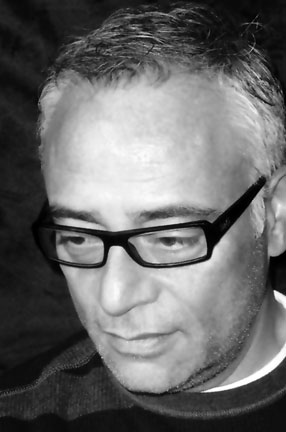
Víctor Manuel Rodríguez: My name is Víctor Manuel Rodríguez. My connection with the subject of sexuality comprises two components: one is an academic and investigative component, for I pursued studies and obtained my Ph.D. at Rochester University in New York and one of the central subjects in my academic training was queer studies. I began to develop a series of papers and research work revolving around the relationship between a queer perspective and a perspective of the artistic and social movements in Latin America. On the other hand, I am involved in a sort of activism within the local artistic milieu. I have not only written about artists who have worked, or who work on these subjects, but I have also organized and curated exhibitions that attempt to link cultural and visual studies with artistic practices, making the works hold a dialogue in wider contexts and associating them to political struggles, ways of inhabiting the city, ways of constructing the public space, etc.
Perhaps there is a third component of my work. I served as Deputy Director for the Promotion of Art and Cultural Expressions at the District Institute of Culture and Tourism, and as Director of Art, Culture and Patrimony at the District Secretariat for Culture, Recreation and Sports, both these bodies attached to Bogotá’s District Administration. During Lucho Garzón’s term of office, I had the chance to join in his government project for the inclusion of communities marginalized on grounds of ethnicity, gender and sexuality. Our work was aimed at formulating a public policy that would lead the Government to recognize, reestablish and guarantee the cultural rights of these groups. We identified organizations working for cultural changes; we promoted the visibilization and implementation of their cultural practices, and we laid the foundations for the State to fulfill its obligation to guarantee the right of these communities to diverse ways of living, to non-official modes of inhabiting the city, of occupying the space, of constructing the territory.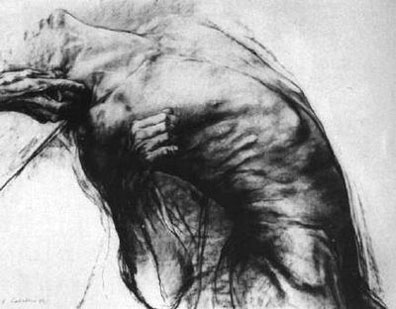
Luis Caballero, Untitled, 1970
Carlos Motta: Let us begin by the theoretical ambit. Can you tell me what the theoretical field prior to the arrival of the queer theory in Latin America, and in Colombia in particular, is?
VMR: In the 1990s there appeared in Latin America an emerging academic movement that echoed the “Gay and Lesbian Studies”. Based on that perspective, sexual identities were vindicated in a somehow essentialist way, in an attempt to incorporate them in the great multiethnic and pluricultural narrative of the notion of multicultural nation or city of the time. In Colombia there were some shy attempts on the part of the academy to begin to address these issues; and by shy I do not refer to the efforts made by the academicians but to the fact that university institutions still questioned the relevance and the seriousness of the studies devoted to those issues. Many of us were linked to the academy and to processes of social and political activism.
The progressive insertion of issues related to sexuality and to social and cultural studies in the academy and among activists began at a later stage, in the framework of the debate confronting the “gay and lesbian studies” and the queer theory. Academicians and theoreticians considered that these were not academic or theoretical options, but rather political ones. The inception of the Ciclo de Cine Rosa in 2000 widened the range of questions on the subject and generated a permanent forum for the discussion not only of issues related to culture and sexuality but also of those associated to human rights and hate crimes, among others. Although the cycle was promoted by the Pensar Institute of the Pontificia Universidad Javeriana, we continued to work in the margins of the academy. The central question addressed by this debate was aimed at shedding light on the politics of academic work, on its connection with social and cultural movements, and on the pertinence of these currents in our social and political context.
One of the most important moments of this debate was the one marked by the initiative to promote the approval of the law on “gay” couples by the Congress of the Republic. To “liven up” the debate, some right-wing congressmen closely linked to the defense of the monogamous and heterosexual family distributed among the members of Congress some videos that illustrated the sexual practices of “fags”. The video had been produced in the United States and it contained detailed descriptions of “fist fucking”, among other practices. This posed an interesting discussion on issues of representation and on strategies of cultural activism, regarding what mechanisms or practices of political activism should be devised to counteract a representation that constructs those communities as sick and perverse groups.
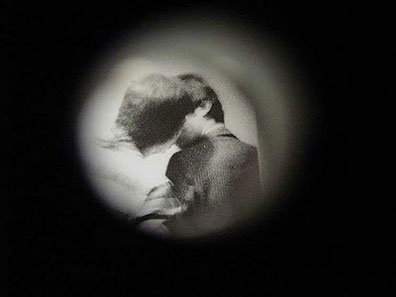
Miguel Angel Rojas, Faenza Series, 1978
CM: Does this discussion take place in the academic ambit?
VMR: No. At the time when this video began to circulate, a group of activists and academicians, myself among them, gathered together to discuss initiatives and lines of action. Two tendencies arose. One of them demanded a response to this video that would demonstrate that we are not sick and perverted people. The other proposed to explore counter-representation strategies not based on an essential “gay” strategy, which would be badly represented, but repeating and deconstructing the mechanisms that characterize representation. The former sought to assimilate couples into a normality criterion, while the latter sought to vindicate the right to be abnormal. A strategy of cultural activism —which was never implemented — was proposed; it consisted in taking the gay bars in Bogotá and replicating the medicalization implicit in the congressmen’s attack by considering the bars itinerary as a great hospital. For example, the bars for teenage socialization would be represented by the neonatology ward, the bars for elderly adults would be the geriatric ward, and the Congress premises would be the “vaccination clinic” where people were vaccinated against homophobia. It goes without saying that proposing the Congress to be a vaccination clinic had a strong ironic content, since the “injections” required syringes of considerable dimensions.
CM: The concern has arisen in different contexts regarding the fact that the queer theory has been left aside by the social movements in a strategic way in order to implement a policy that replicates the norm and acquire an equality of rights without inquiring further into what a diverging or more plural sexuality might be. What is this issue like in Colombia?
VMR: I think that the local community has been tactical and strategic at the same time. From a tactic perspective, the fight for the guarantee of rights has shown a marked tendency towards normalization. But this is inevitable; the fundamental rights of communities with diverse sexualities in Colombia are permanently infringed: the fundamental right to life, for instance. However, this position has facilitated more strategic medium and long-term processes. This tactical and at the same time strategic outlook has conciliated the claims of the movements that demand normality and of those that seek divergence, resorting to the discourses and legal frameworks they have at hand. In an atmosphere of reciprocal solidarity, efforts have been made in order that this recognition does not prevent the development of diverging ways of being, and of experiencing sexuality.
CM: Some of the people who have been linked to the changes in the legislation say that the majority of the members of the community want to live in a normative way; however, the trans communities, or intersex persons who are considered identity categories not necessarily binary remain in a limbo. I wonder if in Colombia there has been a history of artistic expressions addressing that subject and creating a sphere of thought production through the aesthetic or the discursive.
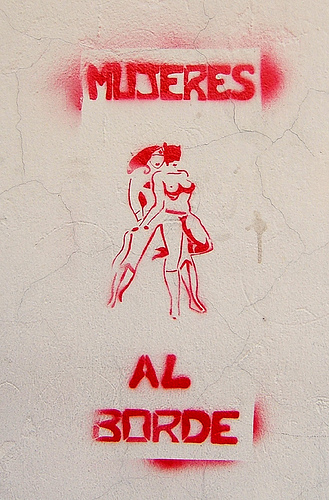
Mujeres al borde, street graffiti
VMR: I think that the resistance of these movements and these social groups to normality has also led them to resist that their forms of representation be included within artistic perspectives or cultural movements. What has been achieved is recognition of the divergent without demanding that these communities self-represent themselves through those languages and those institutional frameworks.
But going back to the subject of theoretical debates, queer studies, Post-structuralism, Post-modernism, etc., are often accused of having been produced elsewhere. In the presence of that objection, I propose that in globalization and, as a matter of fact, after World War II, “elsewhere” is no longer here or there. I find a strong relationship between the ways of living sexually and thinking the politics on sexuality both here and there, because there is no longer a here and a there. What must be specified, however, is that what is important about the queer theory is not its place of origin but the way in which we can use it in the framework of local conflicts and struggles in a context of colonial conditions.
Latin American professors working in the United States and in Latin America have posited the Modernity-Coloniality Project which takes a distance from subordinate and post-colonial studies, although it compiles and reads them, because it considers that the societies of Latin America and the Andean Region have different historical and colonial legacies. One might say that they are colonial societies, but not all colonial contexts are the same. Coloniality is read from an ethnic point of view. What Aníbal Quijano — one of the most important referents — maintains, is that the whole of Latin America’s colonial structure is mounted upon the problem of ethnicity, and this has implied that the most important developments of the Modernity-Coloniality Project revolve around ethnicity. I find this reading disturbing because it also excludes other social movements and cultural and artistic processes which do not revolve around ethnicity, but which are also generating forms of social affiliation linked to sexuality, for instance, and which are moving the politics of those countries in a way that is neither foundational nor utopian.
The whole of Colombia Diversa’s exercise —turning the Political Constitution around and placing it at the service of the sexual minorities — is an exercise that I would term queer because it has sneaked in through the interstices of the Constitution itself; it is “queering” the Political Constitution. It has acted in such a way that it has made the guarantee of the community’s rights possible without getting into utopian discussions regarding the transformation of the State; they have done so through the interstices and, in a way, pushing the constitutional principles to the limit.
In Colombia there is a difficulty or an advantage: these studies have not had the possibility to become incorporated into academic spaces associated to universities. They seem to be linked, rather, to the political and cultural management of the social movements. They move within political activism; people do things, and they theoretize about those things, and to theoretize they make use of whatever theory they have at hand. 
Facebook page of Asociación Madonna y sus divas
CM: I would like you to refer to the development of artistic practices that handle this subject, not necessarily from a particularly aesthetic perspective, but from the perspective of activism and the relationship between these practices.
VMR: The artistic and cultural subject is very interesting, because it begins with a movement of young artists who start to think about that topic and to explore, from the perspective of artistic practice, the cultural constructions of sexuality. My revision is aimed at questioning the way in which the art institution itself has been addressing issues of diverging sexualities. Thus I perceive a double record in the development of these artistic works: on the one hand, there is the subject of the cultural construction of sexuality, and on the other, how these works hold a critical dialogue with respect to the art institution. Alongside the theme of sexuality, which appears in the work of artists such as José Alejandro Restrepo, who did something on transgender from a non-transgender place, there are other works which denote an interest in showing, in generating a dialogue, in generating reflection, and some very interesting curatorial exercises appear.
In 2003 I curated the exhibition “Un caballero no se sienta así” (“A gentleman does not sit like that”), which sought to understand the non-artistic relationships that marginal sexual groups establish with art and how the sense of art is somehow transformed to become incorporated in the political and cultural agenda of social movements. It is a non-artistic appropriation of artistic icons for the benefit of the community, to insert it in their political agendas. This causes me great concern as a curator, as a researcher and as an academician, because I feel it is an exercise in treason against the art institution and against its modernist and developmental idea about all of us having to appropriate the works from an aesthetic and formal point of view.
The classic case is that of Luis Caballero, that was the subject of this exhibition. His work circulates in the LGBT milieus as an icon or identification emblem. However, nobody has a work by Luis Caballero for the reasons that art critics used to describe Luis Caballero as a great artist, which he undoubtedly was. The communities utilize the artistic discourse as an excuse to hang the picture of a naked man in the dining-room or the sitting-room and say they are exhibiting art. I have been developing brief works, essays and exhibitions that revolve around this critical relationship between artworks and the way in which the different movements appropriate them.
The relationship between art and sexuality in Latin America has been a relationship that has been constructed through silence regarding that sexuality; it is not a question of demanding that people should speak about it but of showing other ways in which silence operates, which does not necessarily imply vindicating silence as a strategy of self-representation and cultural fight. Silence functions as a strategy of the historical artistic discourse but also as a strategy of resistance, and such is the case of the gay couple that purchases the painting because it allows them to hang the image of the naked man in their sitting-room while at the same time they can keep the secret of their sexuality, since what they have is a work of art, and they can thus avoid the violence of homophobia. The title of the exhibition is derived from this. The guy buys the Luis Caballero; he hangs it in the dining-room, his mother comes along and asks him: What is that? And he answers, in historical artistic terms: It’s a Caballero. But she replies from a non-historical artistic point of view: a “caballero” (a gentleman) does not sit like that.
After that exhibition, we gradually created an informal collective of artists, curators, and people engaged in cultural studies with the intention of addressing the relationship between cultural and artistic processes, and sexuality. We presented the exhibition “Yo no soy esa”, (“I am not that woman”), which inquired into the different forms of resistance of the queer Bogotá of the 1980s. It attempted to establish a connection between artworks and non-official sexual practices within a framework of resistance both to the normalization of queer lives during that period and to the art institution. Such is the case of Miguel íngel Rojas. In the 1970s and 1980s, he produced a series of photographs showing the spaces for gay encounters in theaters, public bathrooms and parks. The first time he was asked to exhibit in a gallery, he showed these photographs in a 0.5 millimeters in diameter format. Nobody sees anything, and I wonder: What is this work resisting? What it is resisting is, precisely, that this queer world be transformed into art and strengthen the art institution. It seems to say: this world is not for you. This world is not at the service of artistic voyeurism, so to speak. The work always resists being seen, being understood, and there is a scenario that renders translation impossible. One sees this photograph, and if one does not form part of the universe of this subculture, one can hardly realize that one is in the restroom of the Faenza Theater, looking at someone who is returning the gaze.
We have established a dialogue between these classic works of Colombian art and people who are carrying out more contemporary research. In a parallel way, there have been other exhibitions in which an attempt is made to refer to the issue, and that is healthy. In “Yo no soy esa”, the rendering was not artistic, and that generated some difficulties for its reading on the part of the art world. We showed the way in which the works of art articulated with broader cultural universes and how those cultural universes had constructed a queer, underground city, profoundly rich in forms of resistance, but which was not artistic. 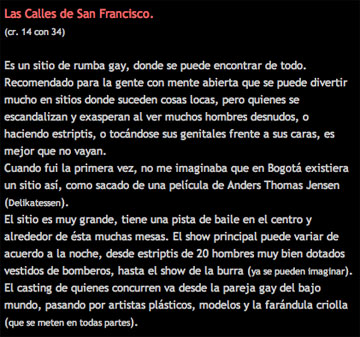
Listing for Las calles de San Francisco bar, 2005
CM: Do you have any experience in the utilization of artistic strategies within cultural ambits in minority communities, whether they be gay meeting points or places for prostitution, for example?
VMR: As a result of all the work with cultural organizations during the Garzón term of office, we identified organizations that had incorporated the cultural issue in their agendas, not only from the point of view of the change in homophobic representations, but also from the point of view of their representation as a group. We might mention at least 35 organizations in Bogotá that have incorporated that topic as fundamental. Part of the exhibition we are organizing at present is aimed at exploring those organizations and the way in which they represent themselves through all those mechanisms, starting with their names: there is an organization called Madonna and her divas; another one is called Women on the Verge, which are appropriations of icons of popular culture. What is interesting is the way in which these organizations are generating dialogues with the artists who work on those issues. Madonna and her divas holds a dialogue with works by young artists in some aspects; it also develops appropriations from popular culture for artistic and non-artistic purposes. This generates a very interesting space for research of the intercrossing between the artistic and the non-artistic, between what occurs not in the artistic or the non-artistic space, but in both places. There is a permanent struggle to remake and resignify what is understood as artistic in each of those spaces.
I believe in considering the territories of curatorship territories of cultural and political activism and not an artistic or academic exercise making it possible to construct a space for reflection on art, culture and sexuality
CM: A recent face of the global activism of social movements has been the utilization of strategies of performance and queering. Activists from Northern Europe face the police in Heidelberg dressed as women or exhibiting their transgender breasts and creating some very strong images against a sort of very hegemonic heterosexual power in relation to the queer practice, as if this represented the alternative, the idealistic, the utopian, the opposition. I wonder if this kind of practice occurs in Colombia, that is, if there is a way to express opposition from that perspective. 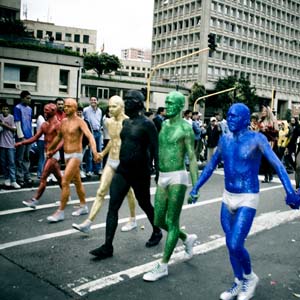
Gay Pride March, Bogotá, 2009
VMR: The space for public demonstration has always been centralized in the LGBT march. The character of “march” is vindicated because it is a citizen’s march. Here you find these forms of representation. When the issue of couples did not prosper in Congress for the second time, there was a movement in front of Bolívar square, although without an idea of self-representation in the terms you indicate. We are carrying out research on the concept of public demonstration in a wider sense than that of a march that takes place on 28 June. I find the opposition to power from that perspective very interesting, not necessarily to promote or advocate a cause associated to issues of sexual orientation or gender identity, but related to power. It would seem that power is always this masculine, heterosexual, normative figure hallmarked within a police or a military uniform.
CM: What are we like? Not in terms of what your lesbian friend pretended, bringing the psychologist to tell us that we are normal, but in terms of the sub-cultural practices of the LGBT community, practices like the ones that could be seen in the pub Las calles de San Francisco, of live sex with animals, among others.
VMR: I feel that the city has also been the subject of normalization practices, and that at present the proliferation of those things that we might term counter-cultural is somehow normalized. Things happen, but mostly in spaces that have become normalized, that is, the normalization of gay life forces us to explore other spaces. These counter-cultural sexual expressions have somehow become relegated to a space in which one must pay to see.
CM: I think it is very interesting to know whether the progressive processes of legislation, the cultural changes derived from the politization of the sexual issue, the consolidation of an official movement and the growing citizen tolerance towards diverse sexuality have somehow annhilated the “perverse” practices that occurred in Bogotá and in other parts of the world, practices deeply rooted in art and performance without denominating themselves thus: the go go boys masturbating in the coffins or having sex in public inside a coffin in the legendary pub Las Calles de San Francisco, the drag shows in the pub La pantera roja, which were expressions of a passionate transvestite sexuality...I feel these things have calmed down, they are not so much on the surface.
VMR: I don’t believe that a consequence of the social and political struggles in favor of the legalization of some rights which have been infringed may be the disappearance of a “perverse”, underground sexualtiy. Sexuality always de-stabilizes any ideas of hegemonic order, both individual and social. Because of my age I remember that Bogotá’s queer scenario in the 1980s permitted some forms of articulation and solidarity that were strictly queer in the sense that they were not circumscribed to the LGBT community exclusively but to all the “weird” people who gathered together in public and private spaces and who shared the idea that we were not “normal”. But of course, today those scenarios of solidarity, of collective fight against normality are not there because there has been a proliferation of a gay popular culture: there are 140 gay pubs in Bogotá, for example, that guarantee socialization spaces for some, and represent normalizing spaces that must be resisted, for others.
The fight for rights is valid and legitimate. Anything that lets the State know that the right to life and the right to be different must be guaranteed is fundamental.
CM: I agree, but observing the processes that are taking place in different countries, I perceive that many times the discourse of the LGBTQ movement has disarticulated the right to be different. It is precisely to defend the difference, the idea that I do not feel “normal”, that I feel different, that I am developing this project!
VMR: I totally agree. Just like you, I resist normalization and I deeply value the difference.
↑Top
Read edited transcript in English
Download interview in PDF format ![]()
Descargue el texto en formato PDF en español ![]()
Descargue el archivo de audio (mp4) ![]()
La relación entre arte y sexualidad en América Latina ha sido una relación que se ha construido a través del silencio de esa sexualidad, no se trata de reclamar que deban hablar de ella, pero sí de mostrar otras formas de operar del silencio que no significa necesariamente reivindicar el silencio como una estrategia de auto representación y de lucha cultural. El silencio funciona como una estrategia del discurso histórico artístico pero también como una estrategia de resistencia, y es el caso de la pareja gay que tiene el cuadro porque les permite tener el hombre desnudo colgado en su sala y al mismo tiempo puede mantener el secreto de su sexualidad porque lo que tiene es una obra de arte y evitarse así la violencia de la homofobia.
Una entrevista con Víctor Manuel Rodríguez
Marzo 20, 2010
Casa de Víctor Manuel Rodríguez en Bogotá, Colombia
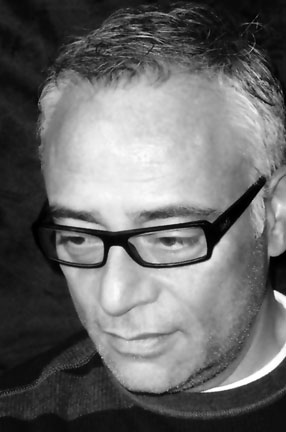
Víctor Manuel Rodríguez: Mi nombre es Víctor Manuel Rodríguez. Mi vínculo con la temática de la sexualidad tiene dos componentes: uno académico y de investigación porque realicé mis estudios de doctorado en la Universidad de Rochester en New York y uno de los temas centrales en mi formación fue los estudios queer. Empecé a desarrollar una serie de trabajos e investigaciones alrededor de la vinculación entre una perspectiva queer y una perspectiva de los movimientos artísticos y sociales en América Latina. Por otro lado, estoy involucrado en una suerte de activismo dentro del medio artístico local. No solamente he escrito sobre artistas que han trabajado, o trabajan, esos temas, sino que también he organizado y curado exposiciones que tratan de vincular estudios culturales y visuales con prácticas artísticas, poniendo a dialogar las obras en contextos más amplios y vinculándolas a luchas políticas, formas de habitar la ciudad, maneras de construir el espacio público, etc.
Quizá, hay un tercer componente de mi trabajo. Fui subdirector de fomento al arte y las expresiones culturales del Instituto Distrital de Cultura y Turismo y director de arte, cultura y patrimonio de la Secretaría Distrital de Cultura, Recreación y Deporte, entidades adscritas a la Administración Distrital de Bogotá. Durante el período de Lucho Garzón tuve la oportunidad de acompañar su proyecto de gobierno para la inclusión de comunidades marginadas por razones de clase, etnia, género y sexualidad. Nuestro trabajo apuntaba a formular una política pública para que el Estado reconociera, restableciera y garantizara los derechos culturales de estos grupos. Identificamos las organizaciones que trabajan a favor de cambios culturales, promovimos la visibilización y despliegue de sus prácticas culturales, dejando sentadas las bases para que el Estado cumpliera con su obligación de garantizar su derecho a formas de vida diversas, prácticas no oficiales de habitar la ciudad, de ocupar el espacio público, de construir el territorio.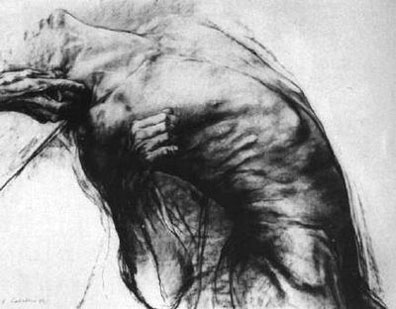
Luis Caballero, Sin Título, 1970
Carlos Motta: Empecemos por el ámbito teórico. ¿Me podrías decir cuál es el campo teórico anterior a la llegada de la teoría queer a América Latina y a Colombia en particular?
VMR: En la década del noventa surge en América Latina un movimiento académico emergente que hace eco de los “Gay and Lesbian Studies”. Desde esta perspectiva, se hacía una reivindicación de las identidades sexuales, en cierto modo esencialista, que buscaba insertarlas en la gran narrativa multiétinca y pluricultural de la idea de nación o ciudad multicultural de la época. En Colombia se llevan a cabo intentos tímidos por parte de la academia para empezar a abordar esas temáticas; digo tímidos no por los esfuerzos que hacían los académicos, sino porque las instituciones universitarias aún cuestionaban la relevancia y la seriedad de los estudios dedicados a esos temas. Muchos de nosotros estábamos vinculados a la academia y a procesos de activismo social y político.
La inserción progresiva de los temas relacionados con sexualidad y estudios sociales y culturales en la academia y entre los activistas inicia más adelante en el marco del debate entre los “gay and lesbian studies” y la teoría queer. Para académicos y teóricos, se entendía que no eran opciones académicas, ni teóricas, sino políticas. Con el inicio del Ciclo de Cine Rosa en el año 2000, que junto con una muestra fílmica promovía un foro de debate sobre estas opciones académicas y políticas, se amplió el espectro de preguntas sobre el tema y se generó un foro permanente de discusión sobre asuntos no sólo de cultura y sexualidad, sino también sobre derechos humanos y crímenes de odio, entre otros. Aunque el ciclo era promovido por el Instituto Pensar de la Pontificia Universidad Javeriana, seguíamos trabajando en los bordes de la academia. La pregunta central en torno a este debate apuntaba a dar luces sobre la política del trabajo académico, sobre sus vínculos con los movimientos sociales y culturales y sobre la pertinencia de estas corrientes en nuestro contexto social y político.
Uno de los momentos más importantes de este debate se dio ante la iniciativa de promover la ley de parejas “gay” para aprobación por el Congreso de la República. Para “animar” el debate, algunos congresistas de derecha, muy vinculados al tema de la defensa de la familia monogámica y heterosexual, repartieron a los miembros del Congreso videos que ilustraban las prácticas sexuales de los “maricas”. El video había sido producido en Estados Unidos y hacía descripciones precisas acerca del “fist fucking”, entre otras prácticas. Se plantea aquí una discusión interesante sobre asuntos de representación y sobre estrategias de activismo cultural, acerca de qué mecanismos o prácticas de activismo político deberían pensarse frente a una representación que construye a esas comunidades como grupos enfermos y pervertidos.
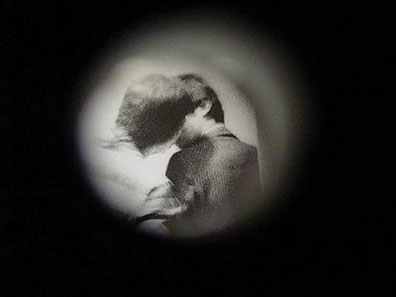
Miguel Angel Rojas, Serie Faenza, 1978
CM: ¿Esta discusión tiene lugar en el ámbito académico?
VMR: No. En el momento en que el video empieza a circular, nos reunimos activistas y académicos para discutir iniciativas y líneas de acción. Se plantean dos tendencias: Una reclama por una respuesta al video que demuestre que no somos enfermos y pervertidos. Otra propone explorar estrategias de contra-representación que no se basen en una identidad “gay” esencial que estaría mal representada, sino que repitan y deconstruyan los mecanismos propios de la representación. La primera buscaba asimilar las parejas a un criterio de normalidad, mientras la otra buscaba reivindicar el derecho a ser anormal. Se propuso una estrategia de activismo cultural, que nunca se llevó a cabo, la cual consistía en tomarse los bares gay de Bogotá, repitiendo la medicalización implícita del ataque de los congresistas, considerando la ruta de los bares como un gran hospital. Por ejemplo, los bares de socialización de los adolescentes estarían en el ala de neonatos, los bares de adulto mayor estarían en el ala geriátrica, y el recinto del Congreso sería “la sala de vacunación” contra la homofobia. Sobra mencionar que proponer que el Congreso fuera la sala de vacunación tenía un alto contenido irónico, puesto que había que “inyectarlos” con jeringas de tamaños considerables.
CM: En diferentes contextos ha surgido la preocupación que la teoría queer ha sido puesta de lado por los movimientos sociales de manera estratégica para implementar una política que replica la norma y adquirir la equidad de derechos sin profundizar en lo que podría ser la sexualidad divergente o más plural. ¿Cómo es este tema en Colombia?
VMR: Pienso que la comunidad local ha sido a la vez táctica y estratégica. En un sentido táctico, la lucha por la garantía de los derechos ha tenido una tendencia marcada hacia la normalización. Pero es que es inevitable, los derechos fundamentales de las comunidades con sexualidades diversas en Colombia son vulnerados de forma permanente: el derecho fundamental a la vida, por ejemplo. Sin embargo, desde ahí se han facilitado procesos más estratégicos a mediano y largo plazo. Esta mirada a la vez táctica y estratégica ha conciliado los reclamos de los movimientos que reclaman normalidad, con los que buscan la divergencia, utilizando los discursos y marcos legales que tienen a mano. En un ambiente de solidaridad entre unos y otros, se ha promovido que dicho reconocimiento no impida el desarrollo de formas divergentes de ser, de estar y de vivir la sexualidad.
CM: Algunas de las personas que han estado vinculadas a los cambios en la legislación dicen que la mayor parte de la comunidad quiere vivir de una forma normativa, sin embargo, las comunidades trans o las personas intersexuales que son consideradas como categorías de identidad que no son necesariamente binarias quedan en un limbo. Me pregunto si en Colombia ha habido una historia de expresiones artísticas que aborden esta temática y creen una esfera de producción de pensamiento a través de lo estético o lo discursivo.
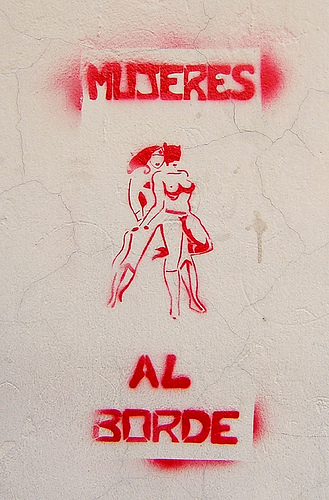
Mujeres al borde, graffiti callejero
VMR: Creo que la resistencia de estos movimientos y estos grupos sociales a la normalidad, hace que también se resistan a que sus formas de representación queden incluidas dentro de perspectivas artísticas o de movimientos culturales. Lo que ha pasado es un reconocimiento de lo divergente sin reclamar que estas comunidades se auto-representen a través de esos lenguajes y esos marcos institucionales.
Pero volviendo al tema de los debates teóricos, los estudios queer, el posestructuralismo, el posmodernismo, etc., son aquí con frecuencia acusados de haber sido producidos en otra parte. Frente a esa objeción planteo que en la globalización y, de hecho, después de la Segunda Guerra Mundial, “la otra parte” ya no está ni aquí ni allá. Encuentro cercanía fuerte entre las maneras de vivir sexualmente y pensar la política de la sexualidad, tanto allá como acá, porque ya no hay un allá ni un acá. Hay que precisar, sin embargo, que lo importante de la teoría queer no es su lugar de origen sino la forma como podemos usarlas en el marco de los conflictos y luchas locales, enmarcados en condiciones coloniales.
Profesores latinoamericanos trabajando en Estados Unidos y América Latina han propuesto el Proyecto Modernidad/Colonialidad, que aunque recoge y lee los estudios subalternos y poscoloniales, toma distancia en tanto considera que América Latina y la región andina son sociedades con legados históricos y coloniales distintos. Uno podría decir que son sociedades coloniales, pero no todos los contextos coloniales son iguales. La colonialidad es leída desde un punto de vista étnico. Lo que sostiene Aníbal Quijano, uno de los referentes más importantes, es que toda la estructura colonial de América Latina se monta sobre el problema de la etnia y eso ha implicado que los desarrollos más importantes del proyecto Modernidad/Colonialidad se den en torno a la etnicidad. Me inquieta esta lectura porque también excluye otros movimientos sociales y procesos culturales y artísticos que no giran en torno a la etnia, pero que también están generando formas de afiliación social en torno a la sexualidad, por ejemplo, y están moviendo la política de estos países de una manera que no es fundacional ni utópica.
Todo el ejercicio de Colombia Diversa, al darle la vuelta a la Constitución Política y ponerla al servicio de los derechos de las minorías sexuales, es un ejercicio que yo llamaría queer porque se ha metido por los intersticios de la propia Constitución; está “queering” la Constitución Política. Ha actuado de forma tal que ha permitido la garantía de los derechos de la comunidad sin meterse en discusiones utópicas, de transformación del Estado; lo han hecho por los intersticios y, de alguna manera, llevando los principios constitucionales a sus límites.
En Colombia hay una dificultad o una ventaja: estos estudios no han tenido la posibilidad de incorporarse a espacios académicos asociados con universidades. Parecen estar más vinculados a la gestión política y cultural de los movimientos sociales. Se mueven en el activismo político, la gente hace cosas y teoriza sobre esas cosas y para teorizar hace uso de la teoría que tiene a mano. 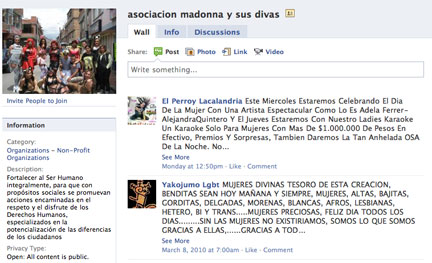
Página de Facebook de la Asociación Madonna y sus divas
CM: Me gustaría que hablaras del desarrollo de prácticas artísticas que manejan esta temática, no necesariamente desde una perspectiva especialmente estética, sino de activismo y la relación entre ellas.
VMR: El tema artístico y cultural es muy interesante porque se inicia con un movimiento de artistas jóvenes que empiezan a pensar en ese tema y a explorar, desde la práctica artística, las construcciones culturales de la sexualidad. Mi revisión apunta a cuestionar la forma como la propia institución del arte ha venido tratando temas de sexualidad divergentes. Percibo entonces un registro doble en el desarrollo de estos trabajos artísticos: de una parte, el tema de la construcción cultural de la sexualidad y, de otra, cómo estos trabajos realizan un dialogo crítico hacia la institución arte. Junto al tema de la sexualidad que aparece en la obra de artistas como José Alejandro Restrepo, quien hizo algo sobre transgenerísmo, desde un lugar no transgenerista, hay otros trabajos en donde se percibe un interés por mostrar y poner a dialogar, a reflexionar y aparecen unos ejercicios de curaduría muy interesantes.
En 2003, curé la exposición “Un caballero no se sienta así”, que busca entender las relaciones no artísticas que grupos sexuales marginales establecen con lo artístico y cómo, de alguna manera, el sentido del arte se transforma para incorporarse a la agenda política y cultural de los movimientos sociales. Es una apropiación no artística de íconos artísticos para el propio bien de la comunidad, para insertarla en sus agendas políticas. Esto me inquieta mucho como curador, como investigador o como académico, porque me parece que es un ejercicio de traición a la institución arte y a su idea modernista y desarrollista de que todos teníamos que apropiarnos de las obras desde un punto de vista estético y formal.
El caso clásico es el de Luis Caballero, que fue el motivo de esa exposición. Su obra circula en los ambientes LGBT como un ícono o insignia de identificación. Sin embargo, nadie tiene a Luis Caballero por las razones que los críticos de arte usan para describir a Luis Caballero como un gran artista, que indudablemente lo era. Las comunidades utilizan el discurso artístico como una excusa para colgar el cuadro de un hombre desnudo en el comedor o en la sala y decir que están exhibiendo arte. He venido desarrollando pequeños trabajos, ensayos y exposiciones alrededor de esa relación critica entre la obra artística y la manera como los movimientos se apropian de ellas.
La relación entre arte y sexualidad en América Latina ha sido una relación que se ha construido a través del silencio de esa sexualidad; no se trata de reclamar que deban hablar de ella, pero sí mostrar otras formas de operar del silencio, que no significa necesariamente reivindicar el silencio como una estrategia de auto representación y de lucha cultural. El silencio funciona como una estrategia del discurso histórico artístico pero también como una estrategia de resistencia, y es el caso de la pareja gay que tiene el cuadro porque les permite tener el hombre desnudo colgado en su sala y al mismo tiempo mantener el secreto de su sexualidad porque lo que tiene es una obra de arte y evitarse así la violencia de la homofobia. De ahí sale el nombre de la exposición. El tipo compra el Luis Caballero, lo instala en el comedor, llega la mamá y le dice: ¿eso qué es? y él le responde en términos histórico artísticos: es un Caballero. Pero ella le responde desde un punto de vista no histórico artístico: un caballero no se sienta así.
A partir de esa exposición fuimos creando un colectivo informal de artistas, curadores y gente proveniente de estudios culturales con el ánimo de abordar la relación entre procesos culturales, artísticos y sexualidad. Realizamos la exposición “Yo no soy esa”, que indagaba sobre las formas de resistencia de la Bogotá queer de los años ochenta. Intentaba vincular obras artísticas y prácticas sexuales no oficiales en un marco de resistencia tanto a la normalización de las vidas queer en ese período como a la institución arte. Es el caso de Miguel íngel Rojas. En los setentas y ochentas realiza una serie de fotografías que registran los espacios de encuentro gay en teatros, baños públicos y parques. La primera vez que le piden que exponga en una galería, las expone en un formato de 0,5 milímetros de diámetro. Nadie ve nada, y me pregunto ¿a qué se está resistiendo esta obra? Se está resistiendo precisamente a que ese mundo queer se convierta en arte y fortalezca la institución arte. Parece decirle: este mundo no es para ustedes. Este mundo no está al servicio del voyerismo artístico, si se le quiere llamar así. La obra siempre se resiste a ser vista, a ser comprendida y hay un escenario de imposibilidad de traducción. Uno ve esta fotografía y, si no forma parte del universo de esa subcultura, difícilmente reconoce que está en el baño del Teatro Faenza, que lo que está mirando es a alguien que lo está mirando…
Hemos puesto en díalogo a estas obras clásicas del arte colombiano con gente que está haciendo investigación más contemporánea. De manera paralela ha habido otras exposiciones en las que se trata de hablar de ese tema y es saludable. En “Yo no soy esa” el registro no era artístico y eso generó alguna dificultad para su lectura por parte del mundo artístico. Mostrábamos la manera como las obras de arte se articulaban con universos culturales más amplios y cómo esos universos culturales habían construido una ciudad queer, underground, profundamente rica en formas de resistencia, pero que no era artística. 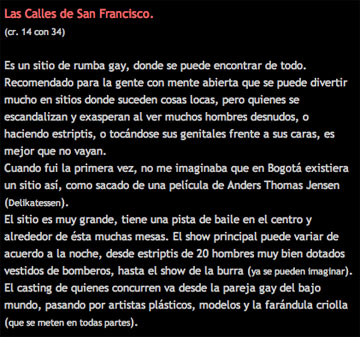
Anuncio del bar Las calles de San Francisco, 2005
CM: ¿Tienes alguna experiencia en usos de estrategias artísticas dentro de ámbitos culturales en comunidades minoritarias, sean puntos de encuentro gay o en lugares de prostitución por ejemplo?
VMR: A raíz de todo el trabajo con organizaciones culturales en el período Garzón identificamos organizaciones que habían incorporado dentro de sus agendas el tema cultural no sólo desde el punto de vista del cambio de representaciones homofóbicas, sino también desde el punto de vista de representación de ellos como grupo. Se podría hablar de por lo menos 35 organizaciones en Bogotá que han incorporado ese tema como fundamental. Parte de la exposición que estamos organizando ahora busca explorar estas organizaciones y la manera como se auto representan a través de todos estos mecanismos; desde los nombres: hay una organización que se llama “Madonna y sus divas”, otra que se llama “Mujeres al borde”, que ya son apropiaciones de íconos de la cultura popular. Lo interesante es la manera como estas organizaciones están generando diálogos con los artistas que trabajan esos temas. “Madonna y sus divas” dialoga con obras de artistas jóvenes en algunos aspectos, desarrolla también apropiaciones de la cultura popular con fines artísticos y no artísticos. Eso genera un espacio muy interesante de investigación sobre el cruce de lo artístico y lo no artístico, de lo que no ocurre ni en el espacio artístico ni en el espacio no artístico, sino en ambos lados. Hay una lucha permanente por rehacer y resignificar lo que en cada uno de esos espacios se entiende como artístico.
Creo en considerar los territorios de curaduría como territorios de activismo cultural y político y no como un ejercicio artístico o académico que permita ir construyendo un espacio de reflexión sobre arte, cultura, sexualidad.
CM: Ha sido una cara reciente del activismo global de los movimientos sociales el utilizar estrategias de performance y de queering. Activistas del norte de Europa se enfrentan a la policía en Heidelberg vestidos de mujer o exponiendo sus senos de transgénero y creando unas imágenes muy fuertes contra una especie de poder muy hegemónico heterosexual en relación a la práctica queer como si esto representara lo alternativo, lo idealista, lo utópico, la oposición. Me pregunto si en Colombia ésta es una práctica que tiene lugar, es decir; si hay una forma de oponerse desde esa perspectiva.
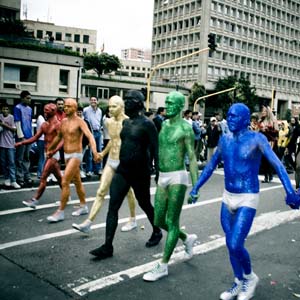
Marcha del orgullo gay, Bogotá, 2009
VMR: El espacio de manifestación pública siempre ha estado concentrado en la marcha LGBT. Se reivindica el carácter de marcha porque es por la ciudadanía. Ahí se encuentran esas formas de representación. Cuando cae por segunda vez el tema de las parejas en el Congreso hubo un movimiento frente a la plaza de Bolívar aunque sin una idea de auto representación en los términos en que tú lo señalas. Estamos haciendo investigación sobre el concepto de manifestación pública en un sentido más amplio que una marcha que tiene ocasión el 28 de junio. Me parece muy interesante el oponerse al poder desde esa perspectiva, no necesariamente para avanzar o abogar una causa que tenga que ver con temas de orientación sexual o identidad de género, sino en relación con el poder. Parecería que el poder es siempre esta figura masculina, heterosexual, normativa, sellada dentro del uniforme de la policía o de los militares.
CM: ¿Cómo somos? No en términos esencialistas, trayendo al psicólogo para que nos diga que somos normales, sino en cuanto a las prácticas subculturales de la comunidad LGBT, prácticas como las que se veían en el bar Las calles de San Francisco, de sexo en vivo con animales, entre otras.
VMR: Siento que la ciudad ha sido también sujeto de prácticas de normalización y que hoy la proliferación de esas cosas que podríamos llamar contra culturales está de alguna manera normalizada. Pasan cosas, pero la mayoría en espacios que se han normalizado, o sea; la normalización de la vida gay nos impone explorar otros espacios. De alguna manera se han relegado esas expresiones sexuales contra culturales a un espacio en el cual se cobra para ver.
CM: Me parece muy interesante saber si los procesos progresivos de legislación, los cambios culturales derivados de la politización de lo sexual, la consolidación de un movimiento oficial y la cada vez mayor tolerancia ciudadana con la sexualidad diversa de alguna manera aniquilan las prácticas “perversas” que ocurrían en Bogotá y en otras partes del mundo, prácticas muy enraizadas en lo artístico y lo performático sin auto denominarse así: los go go boys masturbándose en los ataúdes o teniendo sexo en público dentro del ataúd en el legendario bar Las calles de San Francisco; los drag shows en el bar La pantera roja, que eran expresiones de una sexualidad travesti apasionada... Siento que estas cosas se han calmado, no están tan en la superficie.
VMR: No creo que una consecuencia de las luchas sociales y políticas por la legalización de unos derechos vulnerados sea la desaparición de una sexualidad “perversa” underground. La sexualidad siempre desestructura cualquier idea de orden hegemónico, tanto individual como social. Por mi edad recuerdo que el escenario queer de Bogotá en los años ochenta permitía unas formas de articulación y solidaridad propiamente queer en el sentido en que no estaban circunscritas a la comunidad LGBT exclusivamente, sino a toda la gente “rara” que se encontraba en espacios públicos y privados y que compartía una idea de que no éramos “normales”. Pero claro, hoy esos escenarios de solidaridad, de lucha colectiva, en contra de la normalidad no están ahí porque ha habido una proliferación de una cultura popular gay: hay 140 bares gay en Bogotá, por ejemplo, que le garantizan a unos espacios de socialización y a otros espacios normalizadores que hay que resistir.
La lucha por los derechos es válida y legítima. Todo aquello que le haga saber al Estado que el derecho a la vida y el derecho a ser diferente deben estar garantizados es fundamental.
CM: Estoy de acuerdo, pero observando los procesos que suceden en distintos países veo que muchas veces el discurso del movimiento LGBTQ ha desarticulado el derecho a la diferencia. ¡Es precisamente por defender la diferencia, la idea de que no me siento “normal”, que me siento diferente, por lo cual estoy haciendo este proyecto!
VMR: Lo comparto plenamente. ¡Al igual que tú resisto a la normalización y valoro profundamente la diferencia!
↑Arriba
